The architectural partnership of Simpson, Gillies & Hartland,
which flourished under that name for two decades from the mid-1970s, grew from an earlier sole practice formed in the 1950s
by Gregory Simpson (1910-1987), who began his own career before
the Second World War.
Born on 28 January 1910 in the western Victorian town of Ararat, Gregory Simpson was the youngest of five children of draper Robert Simpson (1876-1940) and his wife, the former Susan Agnes Shannon (1870-1928). Little is known of Gregory’s early life, although he had commenced architectural studies at the University of Melbourne by August 1933, when he was nominated a student member of the Royal Victorian Institute of Architects (RVIA). Subsequently completing the course, Simpson's Bachelor of Architecture degree was conferred on 10 April 1937. Later the following year, he was admitted as an associate member of the RVIA.
In March 1940, Simpson married New Zealand-born Evelyn Joyce Rountree (1911-1988), and the couple subsequently resided in Belgrave Road, East Malvern. By then, Simpson was employed as a draftsman in the Collins Street office of R M & M H King, architects. He was still working there in February 1941, when he became registered as an architect in Victoria. Little else is currently known of Simpson’s professional activity during these years. By 1946, he held the position of honorary architect to the Young Christian Workers’ Movement (YCWM), in which capacity he designed modestly-scaled low-cost dwellings intended to take advantage of recently-enacted co-operative housing legislation.
By December 1946, Simpson and his wife had moved to Auckland, where he was to design a new factory for Korma Textiles Ltd, the New Zealand subsidiary of a pre-war Melbourne company founded by businessman Stan Korman. In a letter to the ARBV written nine month later, Simpson stated that "as the length of my stay in New Zealand is quite indefinite, I can see no value in holding registration to practice in Victoria". Virtually nothing further is known of Simpson's work in New Zealand; as was the case in Australia at the time, there was scant opportunity for private construction in the early post-war years. In another 1947 letter, Simpson related his views of the local construction industry, observing that "a state monopoly of building supplies for houses and flats erected by the state has prevented private enterprise from playing a major role in meeting the housing position in New Zealand". It was not until 1950 that he and Evelyn returned to Australia, whereupon he re-instated his status as a registered architect in Victoria and obtained a position in the Collins Street architectural office of Marsh & Michaelson.
After living for a time in Fitzroy, the Simpsons moved out to Surrey Hills, taking up residence in a bungalow at 621 Whitehorse Road. It was here that, around 1951, Simpson established his own architectural office, working from an infilled verandah at the rear. The practice was initially a small one, with early employees including Oswald "Ossie" James (1922-1999) and Gerrit Hartland (1930-). The latter, a Dutch migrant who had settled in Australia in 1952, joined Simpson at the end of that decade after stints with both Middleton & Talbot and Keith Reid. Harland rose to become Simpson's principal designer, and was responsible for churches, office buildings, factories and several houses, including his own in Forest Hill, one for colleague Ossie James, and another for Simpson's sister. Another key member of the office was Robert Edwin "Ted" Gillies, a former employee of Muir & Shepherd who had maintained his own practice in the 1960s before joining up with Simpson and Hartland. In 1975, Simpson acknowledged the contribution of these two senior staff members by re-badging the practice as Simpson, Gillies & Hartland.
Gregory Simpson died on 18 July 1987, aged 77 years. He was survived by his wife Evelyn and their four daughters including the eldest, Susan, who married a civil engineer and was living in New South Wales. The architectural partnership of Simpson, Gillies & Hartland continued into the early 1990s, when it was finally dissolved due to the Recession. Hartland went on undertake contract work until he retired in 1995. Ted Gillies, long active in local politics and Rotary Club activities, was bestowed with an Order of Australia in 2008.
Born on 28 January 1910 in the western Victorian town of Ararat, Gregory Simpson was the youngest of five children of draper Robert Simpson (1876-1940) and his wife, the former Susan Agnes Shannon (1870-1928). Little is known of Gregory’s early life, although he had commenced architectural studies at the University of Melbourne by August 1933, when he was nominated a student member of the Royal Victorian Institute of Architects (RVIA). Subsequently completing the course, Simpson's Bachelor of Architecture degree was conferred on 10 April 1937. Later the following year, he was admitted as an associate member of the RVIA.
In March 1940, Simpson married New Zealand-born Evelyn Joyce Rountree (1911-1988), and the couple subsequently resided in Belgrave Road, East Malvern. By then, Simpson was employed as a draftsman in the Collins Street office of R M & M H King, architects. He was still working there in February 1941, when he became registered as an architect in Victoria. Little else is currently known of Simpson’s professional activity during these years. By 1946, he held the position of honorary architect to the Young Christian Workers’ Movement (YCWM), in which capacity he designed modestly-scaled low-cost dwellings intended to take advantage of recently-enacted co-operative housing legislation.
By December 1946, Simpson and his wife had moved to Auckland, where he was to design a new factory for Korma Textiles Ltd, the New Zealand subsidiary of a pre-war Melbourne company founded by businessman Stan Korman. In a letter to the ARBV written nine month later, Simpson stated that "as the length of my stay in New Zealand is quite indefinite, I can see no value in holding registration to practice in Victoria". Virtually nothing further is known of Simpson's work in New Zealand; as was the case in Australia at the time, there was scant opportunity for private construction in the early post-war years. In another 1947 letter, Simpson related his views of the local construction industry, observing that "a state monopoly of building supplies for houses and flats erected by the state has prevented private enterprise from playing a major role in meeting the housing position in New Zealand". It was not until 1950 that he and Evelyn returned to Australia, whereupon he re-instated his status as a registered architect in Victoria and obtained a position in the Collins Street architectural office of Marsh & Michaelson.
After living for a time in Fitzroy, the Simpsons moved out to Surrey Hills, taking up residence in a bungalow at 621 Whitehorse Road. It was here that, around 1951, Simpson established his own architectural office, working from an infilled verandah at the rear. The practice was initially a small one, with early employees including Oswald "Ossie" James (1922-1999) and Gerrit Hartland (1930-). The latter, a Dutch migrant who had settled in Australia in 1952, joined Simpson at the end of that decade after stints with both Middleton & Talbot and Keith Reid. Harland rose to become Simpson's principal designer, and was responsible for churches, office buildings, factories and several houses, including his own in Forest Hill, one for colleague Ossie James, and another for Simpson's sister. Another key member of the office was Robert Edwin "Ted" Gillies, a former employee of Muir & Shepherd who had maintained his own practice in the 1960s before joining up with Simpson and Hartland. In 1975, Simpson acknowledged the contribution of these two senior staff members by re-badging the practice as Simpson, Gillies & Hartland.
Gregory Simpson died on 18 July 1987, aged 77 years. He was survived by his wife Evelyn and their four daughters including the eldest, Susan, who married a civil engineer and was living in New South Wales. The architectural partnership of Simpson, Gillies & Hartland continued into the early 1990s, when it was finally dissolved due to the Recession. Hartland went on undertake contract work until he retired in 1995. Ted Gillies, long active in local politics and Rotary Club activities, was bestowed with an Order of Australia in 2008.
Select List of Projects
Gregory Simpson
| 1946 1947 | Co-operative housing for Young Christian Workers’ Movement, Melbourne Factory for Korma Textiles Ltd, Pah Road, Auckland, New Zealand |
Gregory Simpson & Associates
| 1956 1957 1959 1960 1962 1963 1964 1965 1972 | Office and warehouse for Interstate Buyers Ltd, Toroonga Road, Hawthorn Additions to factory for British Australian Paper Company, Burke Road, Gardiner Residence for Gerrit Hartland, 6 Andrew Street, Forest Hill* Residence for Oswald James, 22 Harrington Avenue, Balwyn North* Post office, 9-11 Railway Road, Blackburn Residence for D J Hutchison, 8 Yarra Street, Kew* Mechanics' Institute Hall (Centenary Hall), Watton Street, Werribee Factory for Dayton Tooling Pty Ltd, Gower Street, Preston Additions to factory for Foodland Holdings Ltd, Springvale Road, Waverley Residence for Miss Kathleen Simpson, 13 Alwyn Street, Croydon* Church of St Thomas the Apostle, 57 Central Road, Blackburn |
Simpson, Gillies & Hartland
| 1975 1977 1978 1982 | Senior Citizens Centre, 9-11 Marwal Avenue, Balwyn North* District Office for Forests Commission, Orbost* St Joseph’s Catholic Church, 212 Boronia Road, Boronia* Alterations to Larundel Psychiatric Hospital, Bundoora |
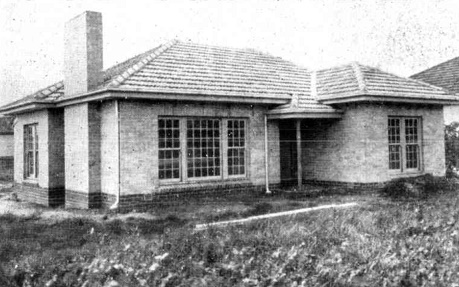 | |
| Typical dwelling designed for YCWM (1946) |
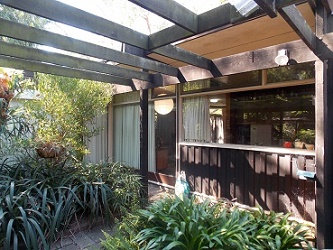 | |
| Gerrit Hartland's own house, Forest Hill (1959) (source: photograph by Built Heritage Pty Ltd) |
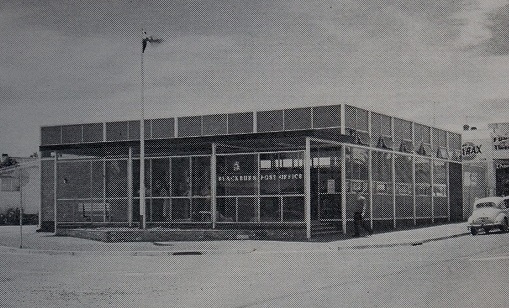 | |
| Post office in Railway Road, Blackburn (1962) |
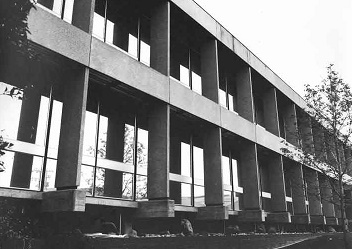 | |
| Office building at Box Hill (1960s) (source: photograph courtesy Gerrit Hartland) |
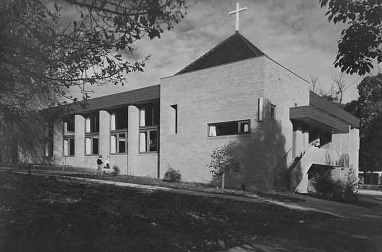 | |
| St Joseph's Church, Boronia (1978) (source: photograph courtesy Gerrit Hartland) |
| Special acknowledgement to Gerrit Hartland, who kindly shared his recollections as well as photographs from his private collection. |
Projects indicated by an asterisk (*) were designed by Gerrit Hartland
top
